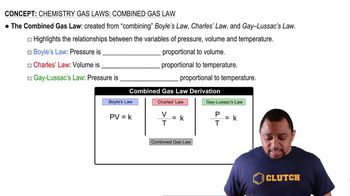Calculate how many moles of NH3 form when each quantity of reactant completely reacts. 3 N2H4(l) → 4 NH3(g) + N2(g) c. 65.3 g N2H4

Hydrobromic acid dissolves solid iron according to the reaction:
Fe(s) + 2 HBr(aq) → FeBr2(aq) + H2(g)
What mass of HBr (in g) do you need to dissolve a 3.2-g pure iron bar on a padlock? What mass of H2 would the complete reaction of the iron bar produce?
 Verified step by step guidance
Verified step by step guidance
Verified video answer for a similar problem:
Key Concepts
Stoichiometry

Molar Mass

Gas Laws

Consider the balanced equation:
SiO2(s) + 3 C(s) → SiC(s) + 2 CO(g)
Complete the table showing the appropriate number of moles of reactants and products. If the number of moles of a reactant is provided, fill in the required amount of the other reactant, as well as the moles of each product that forms. If the number of moles of a product is provided, fill in the required amount of each reactant to make that amount of product, as well as the amount of the other product that forms.
Consider the balanced equation:
SiO2(s) + 3 C(s) → SiC(s) + 2 CO(g)
Complete the table showing the appropriate number of moles of reactants and products. If the number of moles of a reactant is provided, fill in the required amount of the other reactant, as well as the moles of each product that forms. If the number of moles of a product is provided, fill in the required amount of each reactant to make that amount of product, as well as the amount of the other product that forms.
Hydrobromic acid dissolves solid iron according to the reaction:
Fe(s) + 2 HBr(aq) → FeBr2(aq) + H2(g)
What mass of HBr (in g) do you need to dissolve a 3.2-g pure iron bar on a padlock?
For each of the reactions, calculate the mass (in grams) of the product that forms when 15.39 g of the underlined reactant completely reacts. Assume that there is more than enough of the other reactant.
a. 2 K(s) + Cl2(g) → 2 KCl(s)
b. 2 K(s) + Br2(l) → 2 KBr(s)
c. 4 Cr(s) + 3 O2(g) → 2 Cr2O3(s)
d. 2 Sr(s) + O2(g) → 2 SrO(s)
